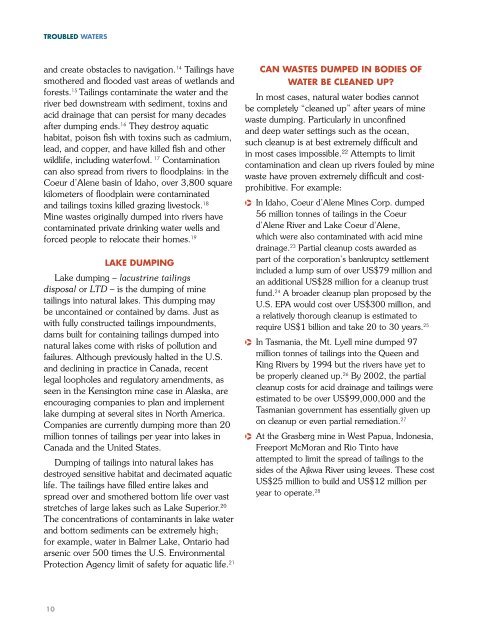Troubled-Waters_FINAL
Troubled-Waters_FINAL
Troubled-Waters_FINAL
You also want an ePaper? Increase the reach of your titles
YUMPU automatically turns print PDFs into web optimized ePapers that Google loves.
TROUBLED WATERS<br />
and create obstacles to navigation. 14 Tailings have<br />
smothered and flooded vast areas of wetlands and<br />
forests. 15 Tailings contaminate the water and the<br />
river bed downstream with sediment, toxins and<br />
acid drainage that can persist for many decades<br />
after dumping ends. 16 They destroy aquatic<br />
habitat, poison fish with toxins such as cadmium,<br />
lead, and copper, and have killed fish and other<br />
wildlife, including waterfowl. 17 Contamination<br />
can also spread from rivers to floodplains: in the<br />
Coeur d’Alene basin of Idaho, over 3,800 square<br />
kilometers of floodplain were contaminated<br />
and tailings toxins killed grazing livestock. 18<br />
Mine wastes originally dumped into rivers have<br />
contaminated private drinking water wells and<br />
forced people to relocate their homes. 19<br />
10<br />
LAkE DUmping<br />
Lake dumping – lacustrine tailings<br />
disposal or LTD – is the dumping of mine<br />
tailings into natural lakes. This dumping may<br />
be uncontained or contained by dams. Just as<br />
with fully constructed tailings impoundments,<br />
dams built for containing tailings dumped into<br />
natural lakes come with risks of pollution and<br />
failures. Although previously halted in the U.S.<br />
and declining in practice in Canada, recent<br />
legal loopholes and regulatory amendments, as<br />
seen in the Kensington mine case in Alaska, are<br />
encouraging companies to plan and implement<br />
lake dumping at several sites in North America.<br />
Companies are currently dumping more than 20<br />
million tonnes of tailings per year into lakes in<br />
Canada and the United States.<br />
Dumping of tailings into natural lakes has<br />
destroyed sensitive habitat and decimated aquatic<br />
life. The tailings have filled entire lakes and<br />
spread over and smothered bottom life over vast<br />
stretches of large lakes such as Lake Superior. 20<br />
The concentrations of contaminants in lake water<br />
and bottom sediments can be extremely high;<br />
for example, water in Balmer Lake, Ontario had<br />
arsenic over 500 times the U.S. Environmental<br />
Protection Agency limit of safety for aquatic life. 21<br />
cAn WASTES DUmpED in BODiES OF<br />
WATER BE cLEAnED Up?<br />
In most cases, natural water bodies cannot<br />
be completely “cleaned up” after years of mine<br />
waste dumping. Particularly in unconfined<br />
and deep water settings such as the ocean,<br />
such cleanup is at best extremely difficult and<br />
in most cases impossible. 22 Attempts to limit<br />
contamination and clean up rivers fouled by mine<br />
waste have proven extremely difficult and costprohibitive.<br />
For example:<br />
q In Idaho, Coeur d’Alene Mines Corp. dumped<br />
56 million tonnes of tailings in the Coeur<br />
d’Alene River and Lake Coeur d’Alene,<br />
which were also contaminated with acid mine<br />
drainage. 23 Partial cleanup costs awarded as<br />
part of the corporation’s bankruptcy settlement<br />
included a lump sum of over US$79 million and<br />
an additional US$28 million for a cleanup trust<br />
fund. 24 A broader cleanup plan proposed by the<br />
U.S. EPA would cost over US$300 million, and<br />
a relatively thorough cleanup is estimated to<br />
require US$1 billion and take 20 to 30 years. 25<br />
q In Tasmania, the Mt. Lyell mine dumped 97<br />
million tonnes of tailings into the Queen and<br />
King Rivers by 1994 but the rivers have yet to<br />
be properly cleaned up. 26 By 2002, the partial<br />
cleanup costs for acid drainage and tailings were<br />
estimated to be over US$99,000,000 and the<br />
Tasmanian government has essentially given up<br />
on cleanup or even partial remediation. 27<br />
q At the Grasberg mine in West Papua, Indonesia,<br />
Freeport McMoran and Rio Tinto have<br />
attempted to limit the spread of tailings to the<br />
sides of the Ajkwa River using levees. These cost<br />
US$25 million to build and US$12 million per<br />
year to operate. 28


